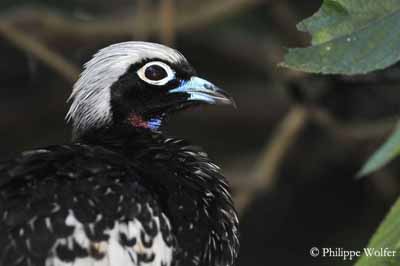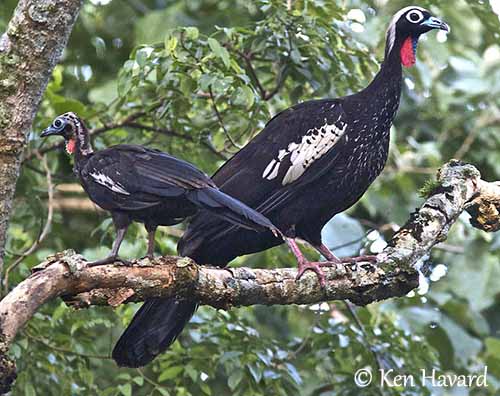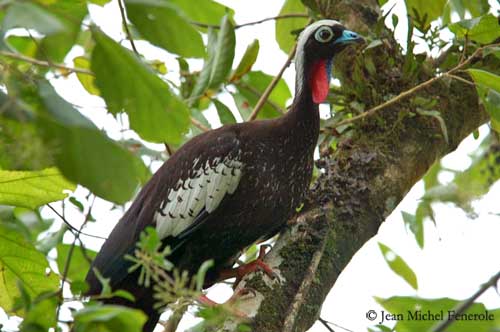
PROTECTION / THREATS / STATUS:
The Black-fronted Piping-guan is an ENDANGERED SPECIES, very rare outside the protected areas.
Declines are due to habitat loss and hunting pressure, deforestation and clearing of forested areas. Poaching is also an important threat.
Captive programs are in progress with the hope of reintroduction, but this species does not breed well in captivity.
Fr: Pénélope à front noir
All : Schwarzmaskenguan
Esp: Pava Yacutinga
Ital: Penelope Jacutinga
Nd: Zwartmaskergoean
Port: Jacutinga
Photographers:
Jean Michel Fenerole
Photos d’Oiseaux
Ken Havard
My Bird Gallery & Flickr gallery 1 & Flickr gallery 2
Philippe Wolfer
OISEAUX D’ARGENTINE
Text by Nicole Bouglouan
Sources:
HANDBOOK OF THE BIRDS OF THE WORLD Vol 2 by Josep del Hoyo-Andrew Elliot-Jordi Sargatal - Lynx Edicions - ISBN: 8487334156
BirdLife International (BirdLife International)
Wikipedia (Wikipedia, The Free Encyclopedia)
Black-fronted Piping-guan
Pipile jacutinga
Galliforme Order – Cracidae Family
BIOMETRICS:
Length: 64-74 cm
Weight: 1100-1400 g
DESCRIPTION:
The Black-fronted Piping-guan is a rare bird vulnerable to hunting and habitat loss, endemic to the Atlantic Forest of Brazil.
Adult has black plumage with bluish gloss. The upperwing shows a conspicuous white patch crossed by small black dots forming black vertical lines. The long tail is black and the underparts too, with some fine white arrows on breast and scapulars.
On the head, face is black with broad, bare, bluish-white eye-ring. Throat shows a large red wattle with blue base. The white crown and nape bear longer, fine, white feathers forming a crest when the bird is excited.
The strong bill is pale blue with black tip. Eyes are reddish-brown. Legs and feet are red.
Both sexes are similar and juveniles resemble adults.

VOICE: SOUNDS BY XENO-CANTO
The Black-fronted Piping-guan utters soft whistles and produces some noise with the wings, named “wing-drumming”.
HABITAT:
The Black-fronted Piping-guan frequents forested areas, humid forest and gallery forest, both in lowland and coastal ranges, occurring too in coastal mountains between 900 and 1800 metres of elevation.
This species feeds on numerous fruit’s species. It can be found more in forest close to streams than in interior forested areas.
RANGE:
The Black-fronted Piping-guan is found in SE Brazil and adjacent regions of Argentina and Paraguay where it frequents Atlantic forest.
BEHAVIOUR:
The Black-fronted Piping-guan feeds mainly on fruits of several plant species such as those of palmito (Euterpe edulis), figs (Ficus) and numerous others.
It takes seeds and buds, but also some insects and molluscs found among the stones on the stream’s shores. It probably takes salt by ingesting mud too.
This bird is often seen in small groups, but it also forages alone or in pairs. Mainly arboreal, it occasionally comes to the ground where it finds fallen fruits and water for drinking. But it is more often seen foraging in the higher parts of the trees than at lower level.
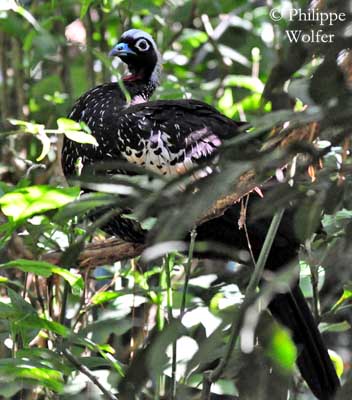
DIET:
The Black-fronted Piping-guan feeds primarily on fruits of several plant species, including mainly palmito and fig trees. It also consumes seeds, grains and buds, and some invertebrates and molluscs found near the water on the shores of the steams.
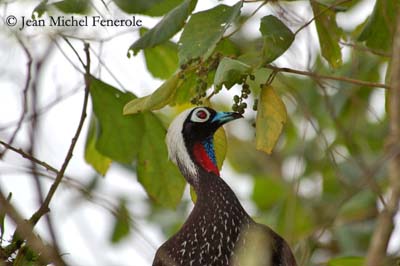
The Black-fronted Piping-guan is territorial and performs some threat displays in front of intruders. It shakes the wings, creating a kind of machine-like rattle.
When the breeding season starts, the group breaks off and pairs are forming.
The Black-fronted Piping-guan performs seasonal and altitudinal movements according to the production of fruiting trees, and mainly of palmito. The fruits of the palmito ripen earlier at lower altitude, and later into the season at higher elevation.
The adults may move briefly after the breeding season.
FLIGHT:
Piping-guans are the best fliers among the Family Cracidae. But usually, they perform glides on concave wings from high perches in trees, with help of the long tail. When a bird looses height, it lands in low vegetation and then, climbs up into the canopy and performs a new glide.
